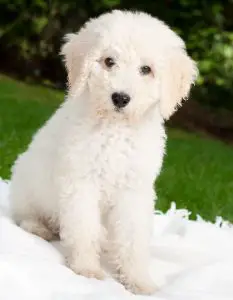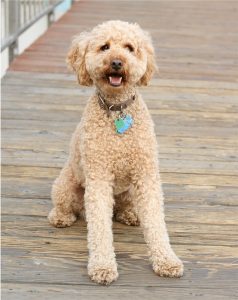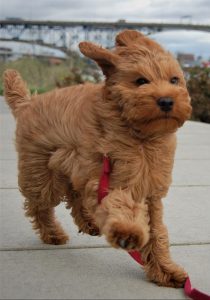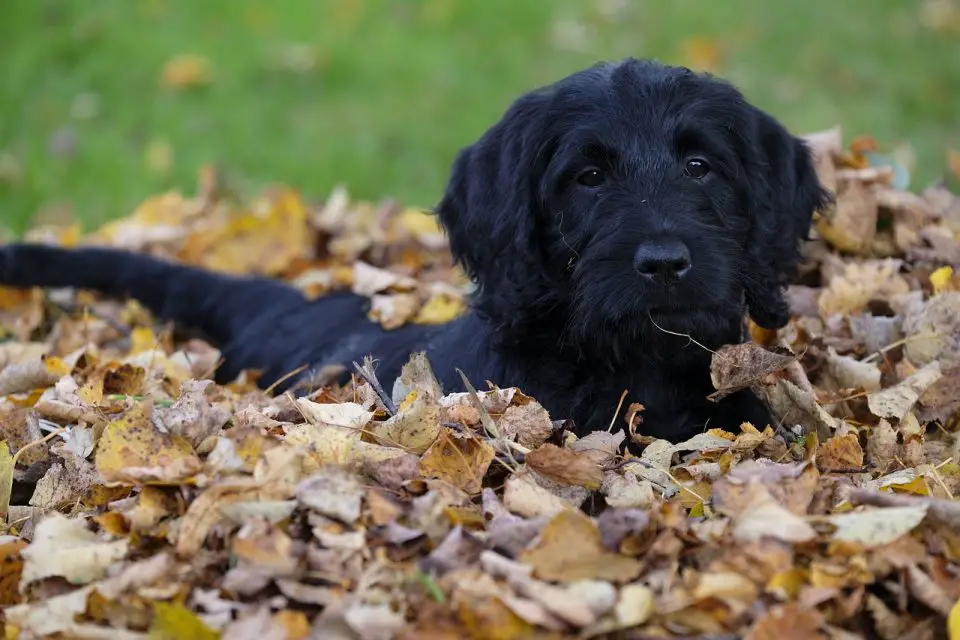Today we’re going to take a look at the question, do Labradoodles shed?
Before we get into all things related to Labradoodle shedding, let’s shed (pardon the pun!) some light on the Labradoodle’s popularity.
To begin with, you may be wondering what a Labradoodle is. Well, it’s a crossbreed dog which has parents of Poodle and Labrador Retriever.
Hence the name Labradoodle. The breed is not a pedigree as many people mistakenly think.
Labradoodles are becoming very popular all over the world now and because of this, a good quality Labradoodle can set you back almost as much as the pedigreed parents.
Why are Labradoodles so Popular?
The primary reason for this popularity is that the breed is recognised to be non or low shedding.
This means that anyone who in the past was allergic to dogs, can now consider having a pooch.
There are other reasons why Labradoodles are so popular.
They make great family dogs, they are excellent with kids, they’re always ready to play, they are ready to cuddle at any moment of the day, and they simply adore their owners.
Labradoodles will gladly become a part of the family, they’re as happy to be out on a walk as they are sitting on the sofa with you.
Types of Labradoodle Coats
 Labradoodle coats come in three different types, depending on their parentage.
Labradoodle coats come in three different types, depending on their parentage.
1) Wavy coats
These are non – to low shedding. You may also hear them called fleecy coats.
2) Straight coats
These coats shed the most. In fact, many breeders avoid them because of this. You may also hear this type of coat called the ‘hair coat.’
3) Curly coats
These are the coats to look for if you want a dog that sheds as little as possible. These thick coats do not smell and are thought to be non-shedding. They are dense with thick curls.
One of the things that make Labradoodles so adorable is the colours of the coats. The colours can change as they get older, although the coat will stay shiny with regular grooming.
Labradoodle coats come in several beautiful colours. You can find apricot, gold, chocolate, black, red, white, caramel and two-tone.
What Constitutes Shedding in Dogs?
Shedding is a normal process in healthy dogs. They will lose their old and damaged hair by shedding it.
New hair will grow, which will eventually die and be replaced. This cycle goes on throughout the entire life of the dog.
The amount of hair that your pooch sheds will depend on the health and breed. It will also depend on the season of the year.
Dogs develop thick hair to see them through the winter. As Spring approaches, they no longer need the thick coat to keep them warm, so it is shed.
This is the time when the most shedding takes place. You may notice that your pooch rolls on the ground a lot more. This is to get rid of the dead hair which will start to itch him before long.
If you keep your dog indoors you may notice that it sheds about the same amount over the year, with no great fluctuations in any season.
While it is impossible to stop your dog from shedding, you can control the amount that builds up in your home simply by brushing your pooch regularly.
The groomer or vet will be able to suggest the best type of brush to use.
So, Why do Dogs Shed?
They shed for the same reason as humans do. Old hair dies and we brush it out. New hair starts to grow, and the cycle continues.
Oddly enough, even hairless dogs shed because shedding relates to not only shedding dead hair but also skin cells.
Why Does Your Dog Shed Excessively?
Some dogs shed more than others and as the owner you will become used to the amount of shedding that happens with your dog.
Should you notice any changes to the shedding pattern you may want to talk to your vet to rule out any health issues.
There are several reasons why your pooch may shed more than you think is the correct amount.
If you notice that your dog sheds more than is normal, or he is developing bald patches, you should see your vet right away.
Food and allergies are a major reason for shedding. Your dog’s food should be from a reputable source, with the right number of supplements and nutrients making up the feed.
Your vet will be able to advise you on the best food for your dog.

Other reasons to shed
- Fungal and bacterial infections
- Pregnancy or feeding
- Certain medications
- Parasites such as fleas and mites
- Sunburn
- Some diseases such as cancer
- Kidney and liver disease
- Immune disease
- Licking due to trauma
Labradoodle Shedding: Do Labradoodles Shed?
The truth of the matter is yes, they do shed. What is good news is that they do not shed as much as other breeds. They shed far less than the parent Labrador Retriever and less than other double coated breeds.
Of course, the amount that your Labradoodle sheds depends greatly on its parents and the type of coat they inherit.
If you plan to buy a Labradoodle you should find out exactly what the parentage is and what the coats of the parents are. This will give you an idea of the coat you can expect on your pup.
Dogs that are classed as non-shedding (even though they still shed a little) have a shedding pattern where the shed hair gets caught in the curls, such as in the Poodle hair of a Labradoodle.
A labradoodle will have an area on his body where the tight curls of the poodle are clearly visible. This may be on top of his head, or on his chest. You may even find tight poodle curls on his legs.
This is why it is so important that you brush your Labradoodle regularly to get rid of the dead hair which is tangled in the curly hair.
Leaving the dead hair entangled will not only hurt your pooch because the knots tighten, there is also a possibility that they cause a skin infection.
The reason why some dogs, even Labradoodles, shed differently depends on the parentage, it is all a matter of genetics.
All dogs lose hair, which grows to a set length, dies and falls out. Some breeds leave huge piles of hair around your house while others do not.
If it is vital that your family has a dog that does not shed, then you may want to focus on a second generation or even a third generation Labradoodle.
First generation Labradoodles (at least 75% of them) will still shed.
If you plan on getting a first-generation Labradoodle and still need a non-shedding pooch you may want to keep the fur as short as possible so there is less chance of shedding.
Labradoodle Shedding: Are Labradoodles Hypoallergenic?
Unfortunately, the answer to this question is ‘no.’ No breed of dog is genuinely hypoallergenic, including the Poodle. Even this breed sheds a little.
Hypoallergenic dogs shed less than other breeds although they can still cause an allergy sufferer distress.
The reason for this is because it is not the shed fur that triggers allergies. This is a very widespread misconception.
What causes us to suffer from allergies to our pooch is rather the protein in urine, saliva and sweat which comes in contact with our skin or is inhaled.
These proteins are airborne and settle on our pet’s fur so when we stoke them or breathe them in, they set off our allergies.
Do ‘Hypoallergenic’ Dogs Exist?
Anyone with allergies who wants a dog will be asking this question. Is there such a thing as a hypoallergenic dog? Does this creature even exist?
The truth is that no dog is ever completely hypoallergenic. There are some who spread less allergens than others, but all dogs to some degree or other have allergens.
Breeds that are classed as hypoallergenic normally shed very little or even not at all. The thing which will start an allergic reaction is in the hair of the dog.
Attached to the hair you will find skin cells as well as saliva from when the dog licked itself. Even urine that is on the fur contains allergens.

Most of the time we never notice that there are particles of hair and skin cells in the air and we breather them in, starting an allergic reaction.
Hypoallergenic dogs simply shed far less than other dogs. Because of this lack of shedding there are fewer particles in the air, so less chance of developing an allergic reaction.
Now, you must be wondering if you’ll ever be able to have a dog. The answer is yes, you can. Many people who have allergies also own dogs.
Hypoallergenic dogs – or dogs that shed less – are also less irritating to the allergy sufferer. It may mean that you dust and vacuum more frequently but the bonus is that you have a furry friend.
Are Labradoodles Good for People With Allergies?
If you feel that you are allergic to dogs, but still want one the best way is to be around a dog for at least 24 hours.
Choose a Labradoodle with a curly coat as these shed the least of the three hair groups. You will have a very good idea at the end of this time whether you can deal with your allergies and have a dog.
Labradoodles may be an excellent option for people with allergies simply because those with curly hair shed less. This breed is also an excellent choice as a pet because of the loving nature of the breed.
So, the answer to the question is yes, Labradoodles can be good for people with allergies because they shed less and make delightful pets.
You may have to brush them more often, and definitely wash your hands after touching them, but they will reward you with a lifetime of friendship.
What Allergies can Labradoodles Trigger?
If you have respiratory issues such as asthma, then being subjected to allergens can make your asthma worse. Your breathing may be a little more laboured and you may wheeze more.
Itchy eyes are a sign of an allergic reaction as can be coughing. If your asthma is under control and you can keep your home as dog hair free as possible, then you may still be able to enjoy a pooch.
The best thing to do is to talk to your doctor about getting a dog. He can best advise you about how to take precautions in an allergic reaction.
About Allergies and Dog Breeds
Once you have decided that a Labradoodle (or any other) is the dog for you it makes sense to visit the breeder.
Try to spend as much time with the pup as you can so that you get an idea of any allergies which may develop. A good breeder will offer you a return policy if you really cannot keep a dog.
With anyone who is susceptible to allergies it is important that your dog is groomed as often as possible. They should be bathed often to remove the allergens from the fur.
Try to keep the fur as short as you can as this will reduce the dead hair from staying among the live hair.
Wash your hands after you touch your dog and if you have asthma, make sure that you always have your medication at hand.
Alternatives to Labradoodles – Does Anything Shed Less?
From my own experience most dogs shed, some shed less than others. These are the best types for anyone who has allergies.
If you can keep the hair short, it reduces the number of allergens in the air, and will make your life easier.
Final Thoughts: Do Labradoodles Shed?
 While some people will simply never be able to have a dog because of their severe allergies, many people will be able to own a dog with some simple precautions.
While some people will simply never be able to have a dog because of their severe allergies, many people will be able to own a dog with some simple precautions.
Keep your pooch groomed and bathed to remove allergens from the coat. Dust and vacuum regularly to prevent dust gathering.
Wash your hands often, particularly after touching your dog, and keep asthma medication at hand.
These are minor changes to make in order to have a furry friend, and as any dog owner will tell you, well worth the effort.
